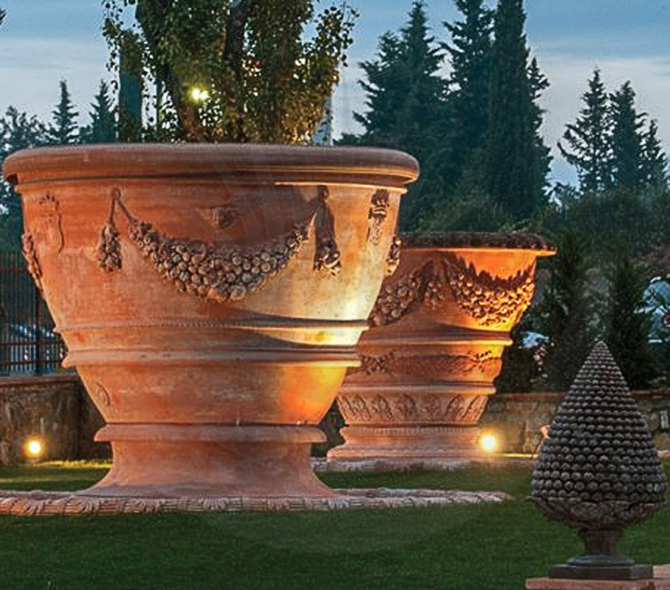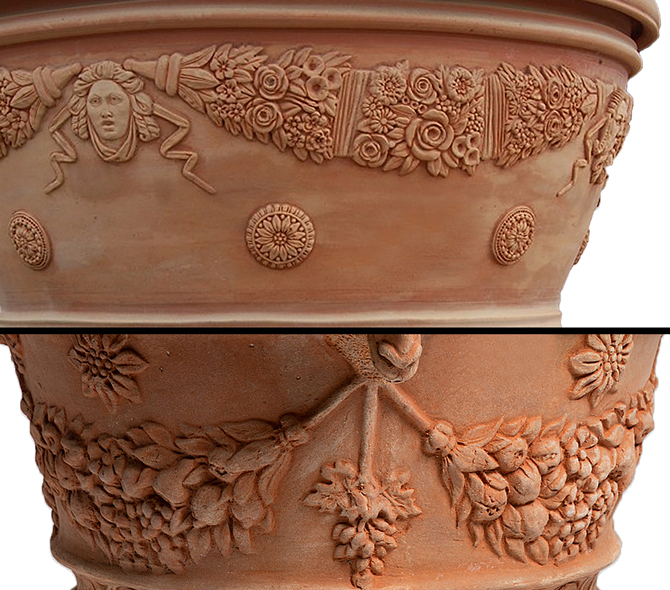
As we know, also thanks to having read other articles on the subject, a vase is a container generally used for growing plants and flowers. Its usefulness, compared
to planting the plant directly in the ground, is that the plant can be moved around when it's in a vase. This is obviously useful for those plants that are sensitive
to the cold and need to be moved to more sheltered environments during cold periods of the year, to avoid them dying. One of these plants is the lemon, which
is why the classic terracotta vase is traditionally called the "lemon vase".
In this article, we present the salient features of the festooned Impruneta vase, which is a decorated variant of the smooth Impruneta vase. The distinctive features
of an Impruneta vase include a bottom that is relatively narrow compared to the size of the upper opening - also known as the "mouth" - and the heavy bands
present in the body of the vase, called "cintole" in Italian.
These pots are produced in various sizes, including very small ones with a diameter of 30 centimeters, as well as very large ones with a diameter of over 200 cm. It is important to remember that, despite causing confusion, many companies continue to identify the size of round pots with the internal measurement, that is, not the external size of the pot, but the useful measurement of the interior space. For a more comprehensive reading, please also see external and internal measurements of terracotta pots.
Normally, the available sizes are spaced by 5 centimeters up to 60-70, and then the interval widens to 10 centimeters. In practice, the sizes generally
available are 30, 35, 40, 45, 50, 55, 60, 70, 80, 90, 100, 110, 120. Beyond 120 cm, they are considered large or custom-made pots, often made entirely
by hand using the colombino technique and the sizes no longer follow specific criteria but rather the particular request of the customer.
What you need to make sure of, when talking about size, is whether you are referring to the internal or external measurement of the pot.
The Impruneta design is a cult for terracotta pots. The shape originates from the Impruneta area near Florence, and later the production was also revived by some companies in the Siena area. There are multiple models available, which have in common the four elements of the Impruneta pot design: the pronounced flaring of the cone, the well-defined bands on the body, the presence of a noticeable recess between the two upper rims, and the meticulous attention to detail in the decoration
But the feature that distinguishes a garland pot from Impruneta from any other decorated vase is that the one produced in Impruneta has festoons made in an artisanal way, original and finely finished. We could define them as small works of art. The main reason is that the historically accepted high price for Impruneta artifacts has allowed those artisans to use more care and time for each produced pot. Garlands and decorations are often applied during the finishing phase with balbotina, and it is possible to achieve levels of definition impossible to reach with castings on molds.

| Technical sheet |
|---|
| Product Name: Garland Imprunetan Pot |
| Made in: Tuscany - Italy |
| Raw Material: Siena Clay, Galestro Clay, Impruneta Clay. The raw material used in the production of this vase is high-quality, natural terracotta clay, which is extracted from the Tuscan hills. The clay is carefully selected and mixed with water, and then worked by hand to create the unique and intricate shape of the vase |
| Production Tecnique: Hand-made casting, Lathe, Gypsum mold Press. The raw material used in the production of this vase is high-quality, natural terracotta clay, which is extracted from the Tuscan hills. The clay is carefully selected and mixed with water, and then worked by hand to create the unique and intricate shape of the vase |
| Finishing: Sponged |
| Color: Terracotta |
| Outer Diameter: by 25 to over 200 cm |
| Usage: This vase is suitable for outdoor use and can withstand harsh weather conditions. It is perfect for use in gardens, patios, and outdoor living spaces |
| Maintenance: This pot requires minimal maintenance and can be cleaned with a damp cloth. Over time, it may develop a natural patina that enhances its beauty and character. See also How to clean terracotta pots |
| Similar Items |
|---|
| Garland Rolled Rim Pot |
| Smooth Imprunetan Terracotta pot |




